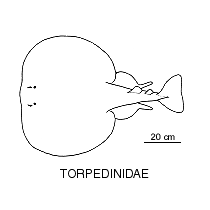- Classification
- CHONDRICHTHYES
- TORPEDINIFORMES
- TORPEDINIDAE
-
Fish Classification
-
Class
CHONDRICHTHYES Sharks, rays ... -
Order
TORPEDINIFORMES Electric rays -
Family
TORPEDINIDAE Torpedo Rays -
Genera
Tetronarce(1)
Family TORPEDINIDAE
Common name: Torpedo Rays
Summary:
A family of electric rays with a large thick flabby disc, a relatively short tail and a large caudal fin. Torpedo Rays have large kidney-shaped electric organs on either side of the disc. These organs are comprised of columns of modified muscle cells called electrocytes capable of producing powerful electric shocks - used to stun and capture prey, as well as a defence mechanism.
Torpedo rays have a more-or-less rounded disc, small eyes, slender jaws that lack labial furrows, a reduced rostrum, five pairs of gill slits, large spiracles, one to two dorsal fins, and a well-developed caudal fin with distinct upper and lower lobes. Maximum size for the family is 1.8 m.
Torpedo rays have a more-or-less rounded disc, small eyes, slender jaws that lack labial furrows, a reduced rostrum, five pairs of gill slits, large spiracles, one to two dorsal fins, and a well-developed caudal fin with distinct upper and lower lobes. Maximum size for the family is 1.8 m.
Cite this page as:
Dianne J. Bray, Torpedo Rays, TORPEDINIDAE in Fishes of Australia, accessed 01 Jul 2025, https://fishesofaustralia.net.au/Home/family/252
References
Compagno, L.J.V. & Last, P.R. 1999. Families Narkidae, Hypnidae, Torpedinidae. pp. 1443-1451 in Carpenter, K.E. & Niem, V.H. (eds). The Living Marine Resources of the Western Central Pacific. FAO Species Identification Guide for Fisheries Purposes. Rome : FAO Vol. 3 pp. 1397-2068.
Helfman, G.S., Collette, B.B. & D.E. Facey. 1997. The Diversity of Fishes. Blackwell Science. 528 pp.
Last, P.R. & Stevens, J.D. 2009. Sharks and Rays of Australia. Collingwood : CSIRO Publishing Australia 2, 550 pp.








